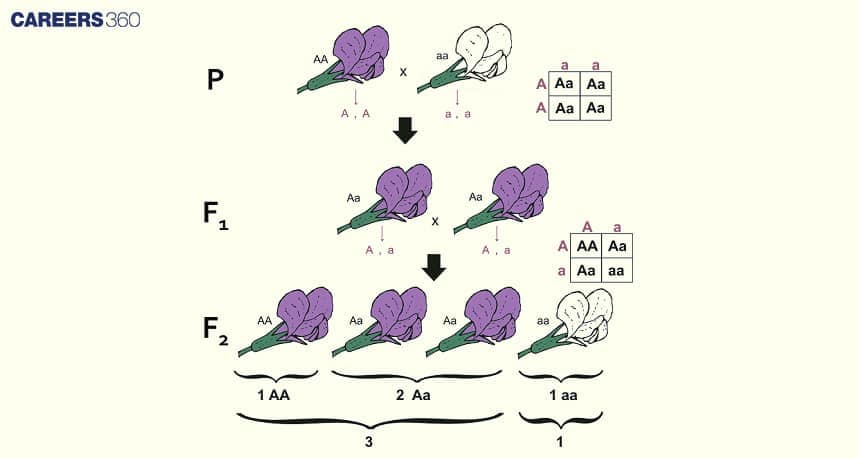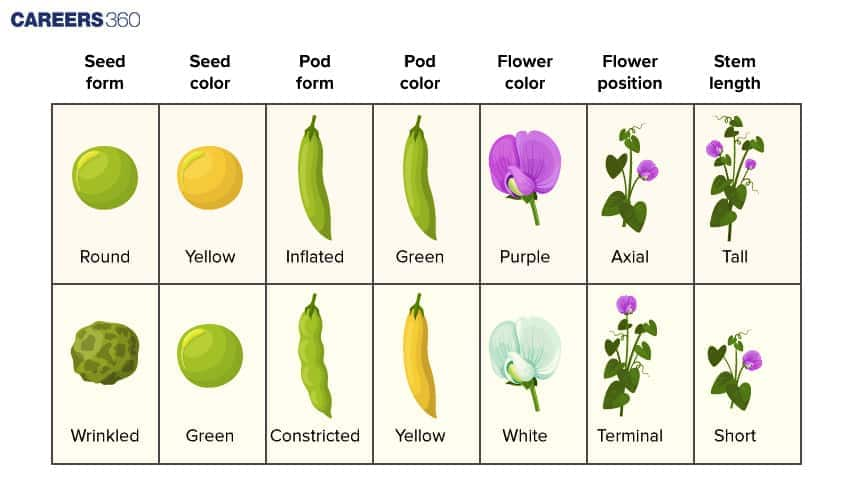Monohybrid Cross - Inheritance Of One Gene: Definition & Example
A monohybrid cross is a genetic experiment in which two different alleles for a specific gene in two organisms are crossed, and it is mainly related to the inheritance of one single trait. This type of cross helps in understanding how one gene is inherited, following the laws of Mendel's inheritance. Monohybrid cross definition includes the study of only one characteristic, such as seed colour or shape, throughout generations. In monohybrid inheritance, one allele is often dominant, which masks the expression of the other recessive allele. This is an important topic from the chapter Principles of Inheritance and Variation in Biology.
NEET 2025: Mock Test Series | Syllabus | High Scoring Topics | PYQs
NEET Important PYQ's Subject wise: Physics | Chemistry | Biology
New: Meet Careers360 B.Tech/NEET Experts in your City | Book your Seat now
- What is a Monohybrid Cross?
- Monohybrid Cross Definition
- Mendel's Laws Of Inheritance
- How To Carry Out A Monohybrid Cross?
- Monohybrid Cross Example
- Genotype And Phenotype Determination
- Video Recommended On Monohybrid Cross - Inheritance Of One Gene

What is a Monohybrid Cross?
A monohybrid cross is a type of genetic breeding experiment that studies the inheritance of a single trait, which is controlled by a single gene locus. This aids in identifying the segregating and recombining nature of alleles in offspring, and this provides fundamental insights into the genetic inheritance pattern, forming the core of modern genetics.
Gregor Mendel, the father of genetics, laid down the foundation of genetic inheritance by systematically experimenting with pea plants in the mid-19th century. He conducted monohybrid crosses very carefully and observed traits such as seed shape, flower colour, and plant height over several generations. His work outlined essential laws of heredity that form the basis of genetic inheritance.
Mendel's approach was systematic and meticulous, focusing on one trait at a time. He used plants that were breeding true for specific traits, meaning plants that consistently passed on the same trait to their offspring when self-pollinated. For example, he crossed tall plants with short ones to investigate the inheritance of plant height, ensuring accurate results.
In a monohybrid cross example, such as Mendel's experiments with pea plants, he focused on one trait at a time-for example, seed shape-for the purpose of analyzing inheritance. The results of Mendel's monohybrid cross were often summarized by using a Punnett square, which helped predict the genotypes and phenotypes of the offspring.
Also Read
Monohybrid Cross Definition
A monohybrid cross is a genetic experimentation in which the course of inheritance of a single attribute is studied. This comes with breeding organisms that, at the locus of the said attribute, are homozygous for different alleles: one dominant and one recessive. This way segregation and recombination of the alleles take place in the offspring, thus representing classical inheritance patterns, such as dominant or recessive traits.
For example, Mendel's genetics is one characteristic such as colour and seed shape in pea plants with Mendel's monohybrid cross. Through this method, he could see how individuals might express monohybrid inheritance and the law of dominance and recessiveness of an allele.
Such a cross can have its possible genetic outcomes predicted using a diagram for a monohybrid cross or the Punnett square. Here, outcomes for a monohybrid cross example are derived based on the segregation of one gene into gametes. This experiment is thus important for understanding genetic inheritance and how traits are passed on from one generation to the next.
Mendel's Laws Of Inheritance
Mendel formulated two basic principles of heredity: the Law of Segregation and the Law of Independent Assortment. The first law states that alleles segregate randomly during gamete formation, while the second one indicates that alleles of different genes assort independently during gamete formation. These two laws lie at the heart of monohybrid crosses, which predict genotypic and phenotypic ratios in offspring.
How To Carry Out A Monohybrid Cross?
A monohybrid cross would require the steps that fully explain how traits are passed down from one generation to the next. The following are the steps for carrying out a monohybrid cross:
Steps for Carrying Out a Monohybrid Cross
Identification Of Parental Traits
Select organisms that differ only in one characteristic of interest, such as the colour of the flower in plants or the colour of fur in animals. For example, you can select pea plants with yellow and green coloured seeds. YY for Yellow, yy for green.
Determine Parents' Genotype
Firstly, research data on the genetic content of organisms chosen for the experiment. See if they are homozygous, with the same alleles, say YY or yy for the trait, or heterozygous having different alleles, for instance, Yy.
Perform The Cross
Cross a homozygous dominant (YY) with a homozygous recessive (yy) parent, or cross two heterozygous parents (Yy) with one another to view both the dominant and recessive alleles in the offspring.
View Offspring in F1 Generation
Allow the parents to undergo natural self-pollination, or mating depending on the organism. Collect the seeds or offspring from the cross for genetic analysis.
Genotype And Phenotype Ratios
Use Punnett squares or probability to predict the genotype ratio and phenotype ratio among offspring. Punnett square is a method of showing all of the possible combinations of alleles that each parent can contribute, along with the probabilities.
Offspring Phenotype Analysis
Observe the phenotypes of the offspring for different traits they express. Record the number of offspring that have the dominant and recessive traits.
Interpret Results
Compare observed ratios of phenotypes to the predicted ratios in the Punnett square. Compare whether the traits are according to Mendelian inheritance (e.g. 3:1 ratio of dominant: recessive trait in the F1 generation). Make Inferences: Describe how alleles segregate and combine in the offspring based on these results. Explain what this means for both dominant and recessive alleles and the resulting phenotypes.
An Example of a Monohybrid Cross

Monohybrid Cross Example
An example of a monohybrid cross is:
Gregor Mendel’s Peas
Gregor Mendel, in the mid-19th century, did scientific experiments about pea plants that eventually proved to be the very foundation of our present understanding of monohybrid crosses and genetic inheritance. Mendel followed the inheritance of individual traits, such as seed colour and seed texture, through generations and presented principles of genetic inheritance in a very lucid and systematic way.
One of the most renowned experiments done by Mendel was related to studying seed colour in peas. Mendel carried out controlled breeding experiments in plants with homozygous yellow seeds (YY) crossing those with plants with homozygous green seeds (yy). All of the first generation, F1 ended up having offspring that produced yellow seeds. Hence, it looked like the yellow allele dominated over the green allele and also managed to make a great masking job over it.
In successive crosses, Mendel crossed the heterozygous yellow-seeded plants of the F1 generation among themselves. The offspring, or the F2 generation of plants, was three yellow-seeded to one green-seeded, in the ratio of 3:1, that is YY or Yy and yy, respectively. This 3:1 ratio thus vindicated Mendel's hypothesis regarding the inheritance of flower colour and proved the existence of a dominant and recessive allele.
This experiment is a classic monohybrid cross example that explains monohybrid inheritance. Mendel's controlled breeding established the predictable pattern that one gene follows in terms of its inheritance, such that the dominant allele masks the presence of the recessive allele. The principle is widely applied in the explanation of the outcome of a monohybrid cross in biology, and tools like the Punnett square explain it. The work is often referred to as Mendel's monohybrid experiment, which confirmed the basic principles of genetic inheritance.
The diagram given below shows the different characteristics of peas used by Mendel in his experiments

Huntington's Disease
Huntington's disease is a case of monohybrid inheritance occurring in humans, and that example is used to illustrate the interaction between dominant and recessive alleles. It is caused by a mutation in the HTT gene on chromosome 4. The child has a 50% chance of having the disease if one of the parents contributes a single copy of the mutated gene (Hh). Inheritance of two copies, HH causes a more severe illness, while the normal gene, hh does not result in Huntington's disease at all.
The fact it is dominant means a single copy of the mutated gene is enough to cause the disease, thus allowing monohybrid crosses to predict the probability of inheritance. This only purely genetic disorder, therefore, stresses the need to understand the genetic risk factor and the associated ethics relevant to the genetic counselling and testing of a hereditary disease.
Confirming Dominant Traits
Monohybrid crosses confirm the claims of dominant traits among characters because one can see the trait steadily within the offspring, thus proving dominance in one allele over another.
Genotype And Phenotype Determination
Genotype refers to the makeup of an organism genetically, for instance, AA, Aa, or Aa. The phenotype refers to the expression of genes that can be identified, such as tall and short. Homozygous has two identical alleles of a certain gene and is represented by AA or aa, while heterozygous has two different alleles of a certain gene, for example, Aa.
Genotype and phenotype ratios can be determined using monohybrid crosses. This can be explained by the fact that crossing two heterozygous tall pea plants, Tt x Tt, gives the ratio 3:1 for tall, TT or Tt, to short, tt.
Dihybrid Cross
A dihybrid cross is a type of genetic experiment where two different traits are studied, being controlled by two gene loci. So, some of the important points that should be realized about dihybrid crosses are:
Two Traits: The dihybrid cross involves crossing entities that have a difference in two traits—for example, seed colour and seed texture in peas.
Law of Independent Assortment: Mendel's Law of Independent Assortment expresses that alleles of different genes isolate independently during the formulation of gamete rolls, making way for all possible combinations of traits in offspring.
Punnett square: It permits the calculation of the possible genotypic and phenotypic ratios of offspring from a dihybrid cross.
Genetic Diversity: Dihybrid crosses illustrate one of the ways the genes for several different features assort independently the genetic diversity within a population.
Dihybrid crosses are needed to understand the workability of genetic diversity and the inheritance pattern of multiple traits that detail the complexity of genetic interactions.
Test Cross
A test cross is a genetic cross designed to determine what an organism's genotype is when it expresses a dominant phenotype but its genotype is not known. When crossed with another plant homozygous recessive for the same character, the phenotypic ratio of the offspring produced will be either homozygous or heterozygous. It is a method mainly used in establishing homozygous dominance and heterozygosity of an organism with dominant phenotypes.
Also Read
Video Recommended On Monohybrid Cross - Inheritance Of One Gene
Frequently Asked Questions (FAQs)
A monohybrid cross refers to genetic experimentation on the inheritance of a single trait, controlled by one gene locus. It explains how alleles are segregated and combined in the offspring, therefore giving essential views about the basis of genetic inheritance patterns so important for modern genetics.
In a monohybrid cross, two organisms differing by a single trait—that is, one being homozygous dominant and the other homozygous recessive—are crossed. Then, the offspring are examined to predict genotype and phenotype ratios through the use of tools such as Punnett squares.
Different conclusions, which relate to phenotypic ratios of a monohybrid cross, generally come up with 3:1 in the first generation, indicating the dominance of one allele over its recessive allele. There will be different genotypic ratios depending on whether the alleles are homozygous dominant, heterozygous, or homozygous recessive.
Monohybrid crosses do not consider interactions of genes, epistasis or the effects of multiple genes on one characteristic called polygenic inheritance. The crosses also take an independent assortment of alleles, which in most cases of genetic inheritance is not valid either.
Mendel's Law of Segregation asserts that alleles segregate randomly in gamete formation; that is, each contains only one allele. The Law of Segregation clarifies how single genes, having an effect on a given trait in monohybrid crosses, get passed from parents to offspring and influence their phenotypic expression.
Also Read
02 Jul'25 06:22 PM
02 Jul'25 06:22 PM
02 Jul'25 06:18 PM
02 Jul'25 06:18 PM
02 Jul'25 06:18 PM
02 Jul'25 06:17 PM
02 Jul'25 06:17 PM
02 Jul'25 06:17 PM
02 Jul'25 06:16 PM

